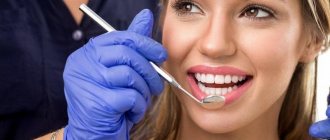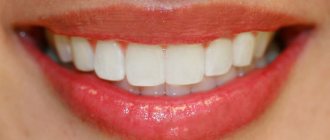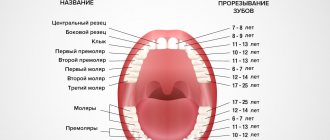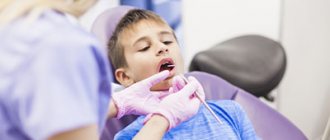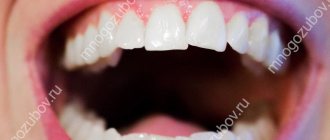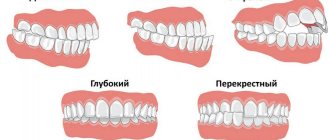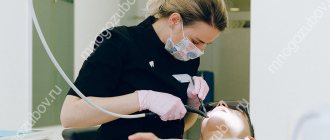Most often, many parents postpone visiting the orthodontist with their child until he is 7-9 years old. However, this is not entirely the right solution, because if there are problems associated with malocclusion, it is easier to solve them before the age of 5. If time has passed, what needs to be done and how to begin correcting malocclusions? At what age can you get braces and until what age do you have braces?
When to put braces on a child
Parents who carefully monitor their children will, of course, immediately notice that their child’s bite is developing incorrectly. Treatment will also be indicated for those babies who:
- parents had a history of malocclusion;
- nasal breathing is impaired as a result of a cold or adenoid disease;
- there are problems with the spine and poor posture;
- bad habits are observed, namely: thumb sucking, other objects and pacifiers for more than 6 hours a day;
- there is a predisposition to diabetes mellitus and diseases of the central nervous system.
Doctors have different opinions regarding bite correction in children. Some believe that it is most successful if it is done at an early age, while others are convinced that older children should have their teeth straightened.
What is malocclusion and why does it occur?
A person has two jaws - upper and lower. The closure of the teeth of the two jaws is called a bite. If this closure is even, the bite is considered correct; if the teeth of one row, when closing, overlap the teeth of the second row, they speak of an incorrect bite. Orthodontists treat such dental disorders. Malocclusion often develops in childhood and can be due to various reasons.
- Difficult pregnancy and childbirth.
One of the common causes is birth trauma, which results in pathologies of the neurological system and musculoskeletal system. These disorders lead to improper development of the jaws.
- Mistakes when breastfeeding.
In a baby, the upper jaw is larger than the lower jaw. When a baby nurses, the jaw muscles naturally tighten and alignment occurs. If the baby is not breastfed or eats incorrectly, the formation of a correct bite may be disrupted.
- Poor posture, problems with the musculoskeletal system.
If a child often slouches, not only the spine is deformed, but also the position of the jaw.
- Lack of teeth.
If for some reason a tooth falls out or is removed ahead of schedule, other teeth tend to take up the vacant space, the habit of gnawing hard objects appears, and the tone of the masticatory muscles is impaired.
Also, the cause of malocclusion may be a short frenulum of the tongue, a lack of vitamins and minerals in the diet. The bite is formed incorrectly in those children who often suffer from acute respiratory viral infections and in whom normal nasal breathing is disrupted. They are forced to keep their mouth slightly open, which leads to abnormal bite development.
At what age are braces placed?
Depending on the age category, the correction of malocclusion is carried out using different methods. For the treatment of children, removable devices are used that actively influence the restructuring of muscles and form the correct development of bones. At this age, the child’s jaws are actively developing, which means they are easily amenable to such correction.
At what age is it recommended to take steps to start treatment? Some experts recommend starting at the age of five, while others argue that the most suitable period is from 7 to 9 years.
Attention! At this age, the use of braces can cause damage to the enamel, so this type of treatment should only be carried out based on compelling medical indications.
In this case, it is customary to take into account the main criteria that determine the readiness of the child’s body to carry out corrective measures:
- the baby has upper permanent incisors;
- The length of the baby’s teeth allows the system to be attached to them.
Orthodontic correction of malocclusion in young children has a positive effect on the development and growth of the jaws, creates conditions for the formation of correct bite, and facilitates correction of the bite in the future.
To correct malocclusion in children aged 11-13 years, fixed structures are used. This time is favorable for the active growth and development of the jaw bones. To select the most favorable time to begin correction, the doctor pays attention to the following criteria:
- general physical development of the child;
- condition of tooth enamel;
- type of bite
12–13 years and older: any violations can be corrected
At this age, a teenager has already formed a permanent bite. If there are violations, they need to be corrected so that there are no health problems in the future: tooth decay due to stress on the enamel, the impossibility of prosthetics due to asymmetry, and so on.
Teenagers can receive the same treatment as adults, such as braces or aligners. The records are already becoming almost ineffective for them. Therefore, they choose between conventional braces (metal, ceramic) or removable aligners.
Teenagers can correct their bite using the same methods as adults.
Both methods of treatment require responsibility: with braces you need to pay great attention to brushing your teeth, and with aligners you need to take care of them, do not lose them and do not forget to wear them exactly as many hours a day as prescribed.
Treatment in adolescents is, on average, faster than in adults, due to the fact that bone tissue is renewed faster, and the growth process at 13 years is far from complete. Therefore, in many cases, aligners are even more profitable, because the cost of treatment directly depends on the duration of treatment. If the doctor calculates that you only need to wear the aligners for 8-10 months, then the price of a set of aligners may be less than the price of a braces system. And since teenagers are often worried about their appearance, aligners will help them decide on treatment more easily - the structures are almost invisible.
Treatment in childhood or adolescence is the best option. In this case, less time is required, the retention stage is shorter. And most importantly, you can prevent the negative impact that malocclusion has on your overall health.
Other articles:
- Retention period - how long does it last and why is it needed?
- How does your face change after braces?
When is the best time to get braces?
If a child has already been diagnosed with an incorrect bite, then the first steps to correct it can be taken immediately. Up to 13 years of age, treatment is carried out using removable plates, since at an early age the bite is not yet fully formed. The jaws reach their permanent position at approximately 14 years of age – it is during this period that it is advisable to get braces for a child. Treatment using them will be the most effective.
In adolescents, molars are already fully formed, so they can already withstand a load that is not entirely natural for them. At this time, the question is no longer raised when it is possible to put braces on a child. But when installing braces before 12-13 years of age, there is a high risk of resorption of incompletely formed roots. After such a procedure, a small patient may lose teeth, so at any age, before carrying out correction using braces, a full diagnostic examination of the condition is carried out.
Why is it important to correct an abnormal bite?
Some parents do not want to put braces on their children, even if the teeth are severely crooked and do not fit together correctly. They believe that crooked teeth do not affect the child’s health, which means they should not interfere with the natural processes of the body.
Dentists do not share this position. They are convinced that malocclusion needs to be corrected because it leads to a number of problems:
- The child’s speech formation may be disrupted and it becomes incomprehensible.
- Crooked teeth interfere with normal chewing of food, which can lead to gastrointestinal diseases.
- Giving a teenager braces is also important from a psychological point of view. Crooked teeth develop complexes in him, attract negative attention from others, which affects the self-esteem of a boy or girl.
It doesn’t matter at what age you noticed a malocclusion in your child. You should immediately make an appointment with an orthodontist. Even if it is too early to put braces on a child, a specialist may recommend wearing an orthodontic plate or other methods of bite correction. In addition, regular observation by an orthodontist is important at any stage.
Installing braces for children
Before starting orthodontic correction of malocclusion in a child, parents need to consider some features:
- It is not recommended to install braces until the second molars have erupted. It is necessary to wait so that each tooth takes its place, since there is a risk of them erupting in another place, outside the dentition. Consequently, the treatment period and the likelihood of relapse will increase.
- Before installing braces, it is necessary to check the condition of the oral and internal muscles. This procedure is carried out in order to exclude dental anomalies and disproportionate development of bone and muscle tissue.
- It is necessary to clarify how the load on the teeth occurs, which is important in preventing relapses. If some teeth close before others, the risk of recurrence of crookedness increases significantly. This information is essential in constructing a consistent correction plan and determining the exact timing of treatment.
How much do braces cost for children?
The cost of children's braces does not differ from the price of adult braces. However, if the pediatric dentist recommends treatment with trainers or plates, it will cost much less. Aligners, on the contrary, will cost more.
You can find out the exact cost of treatment during a consultation before making a decision to install braces. A number of preparatory and supporting procedures and additional elements will also be added to the cost of braces. You can save money on correcting your bite by starting treatment as early as possible, when you can get by with removable structures.
How to install braces
Braces are fixed on the outer and inner surfaces of the teeth using a special material. Modern braces systems are divided into metal, ceramic, and lingual. The cheapest of them are metal ones, the most expensive are lingual ones, since they are attached to the inner tooth platform and are practically invisible. Ceramic devices have no equal in popularity.
Before installing braces, they undergo an examination, followed by preparation of the oral cavity. At this stage, impressions are made from plaster, and a complete sanitation of the oral cavity is carried out. The process of correcting the bite begins at the moment when a special arch is installed in the grooves of the braces, putting pressure on the teeth and causing them to shift.
Installing braces is painless, but discomfort may occur later. Getting used to braces takes about 3-5 days. Depending on the severity of the disease, the braces system is worn from one to three years under constant medical supervision. To consolidate the result, the patient will need to use retainers—special removable plates—for some time.
Rules of care
The design features of braces systems increase the likelihood of developing inflammatory and carious processes in the oral cavity, so you need to take special care of your teeth during the treatment period.
Be sure to follow the following recommendations:
- brush your teeth after every main meal;
- in the morning and evening you need to use special (V-shaped, mono-beam) toothbrushes and brushes;
- use an irrigator and rinse aids.
Parental supervision, especially in the case of younger children, increases the effectiveness of care.
It is also necessary to monitor the child’s diet: you should not eat solid foods (nuts, crackers, seeds), or sticky foods. It is not recommended to drink drinks with food colorings, and you should avoid sports that pose a risk of injury.
You need to brush your teeth with braces not only with a regular brush, but also with a special brush.
Until what age do you have to put braces on your teeth?
Despite the fact that the use of braces presents some difficulties for teenagers, it is at this age that bite correction is most effective. Any changes take place within a year and a half, while for a mature person this is only a minimum period of time. It will take about 2-3 years to establish the bite of an adult, and the retention period will be at least 5 years. A large number of doctors are convinced that to prevent relapse in adulthood, it is necessary to install permanent retainers or use mouth guards every night.
Sources used:
- Canadian Association of Orthodontists
- Proffitt U.R., Modern orthodontics (3rd edition), MEDpress-inform, 2015, 560 p.
- Anikienko, A.A. Hardware orthodontic treatment and its subordination to the physiological laws of irritation / A.A. Anikienko, N.V. Pankratova, L.S. Persin. — M.: Medical Information Agency
- Nanda, R. Biomechanics and aesthetics in clinical orthodontics / R. Nanda. — M.: MEDpress-inform
How long does a child need to wear braces?
The duration of treatment depends on the age of the child and the intensity of the problem. Minor distortions can be corrected in a few months, and serious violations can be corrected in 1–2 years. Rarely do children have to wear braces for longer than 1 year.
The brand of braces also affects the duration of treatment. For example, the manufacturer Damon uses technology to reduce the treatment period by several months, even for adults. The doctor will determine the approximate period during consultation after selecting suitable designs.
Optimal age category
According to orthodontists of the “Smile” dental clinic network, the optimal period for correcting occlusion using braces is from 13 to 18 years. Treatment after adulthood is also effective, but takes longer.
The effectiveness of therapy depends not only on the patient’s age, but also on other associated factors:
- the complexity of a particular clinical case;
- physiological characteristics;
- correctly selected correction system;
- a person’s discipline associated with maintaining oral hygiene and timely visits to the clinic to adjust the orthodontic device.
What do braces fix?
Braces are used to correct bites and eliminate various pathologies. Among the indications:
- malocclusion – problems with the closure of the dentition;
- disproportionate development of the jaws;
- displacement of individual teeth beyond the jaw row;
- jaw deformation during formation;
- large gaps between teeth.
Many bite problems are visible even to non-professionals, but some anomalies will only be noticed by a specialist. Dentists strongly recommend that you periodically show your child to an orthodontist to monitor the change of teeth, evaluate the growth of the jaw bones, and monitor the work of the facial muscles.
Why do parents need to carefully monitor their children's teeth?
Orthodontics is a fairly new science in the CIS countries, but its development and improvement of techniques is gaining momentum every year. Different orthodontists have different opinions regarding at what age children should be given braces. At the same time, more experts believe that bite correction should be done when the child’s baby teeth are replaced by permanent ones, in other words, during the active growth of the jaw bones.
Note: Braces can be used at the age of 50, but you need to understand that the time, starting with the replacement of baby teeth with permanent ones and ending with puberty, is most optimal and gives the best results.
Moral preparation of the child
Any medical intervention is stressful for a developing personality; a preliminary conversation with a qualified specialist is a mandatory stage; it is necessary to establish contact. Some teenagers react painfully to any changes in appearance; in such situations, preference should be given to sapphire or ceramic systems. Most teenagers do not have complexes; after discussing the effectiveness of treatment with peers, studying information on the Internet, and communicating with their doctor, patients agree to a budget option - metal braces.
Main selection criteria
When choosing braces for a teenager, parents need to consider several important points.
Criterias of choice:
- If the speed of treatment is important, then you need to install metal braces to achieve quick results.
- Plastic braces require careful oral care. If the child responsibly follows all the rules of hygiene, then such a system can be installed to correct the bite.
- If a child is embarrassed to wear orthodontic structures, or there is a serious psychological barrier, then it is worth considering the option of installing ceramic braces that are invisible to others.
- If a child is capricious and does not want to give up a number of forbidden foods that can cause damage to the orthodontic system, then it is better to install metal braces, which are characterized by the highest strength.
- Sapphire braces are the best option for installation, but parents will have to spend a lot of money on such a design.
The choice of braces for installation in a teenager should be agreed with the attending doctor. The specialist will help you make the right decision, taking into account the complexity of the clinical case and the patient’s wishes.
How long to wear braces?
Minimum period of wearing braces for teenagers
– 1-1.5 years. In general, the timing of wearing orthodontic systems depends on the complexity of the pathology.
Possible complications
Failure to maintain good oral hygiene and a number of other factors can cause various complications when wearing braces.
When a child wears this design, the following may occur:
- severe pain in teeth or gums;
- allergic reaction to the construction material;
- caries;
- diction disorders;
- weakening of tooth enamel.
When the braces are removed, a lot of space in the dentition is freed up. This can cause additional teeth to appear and become displaced.
A word to an unhappy child but a happy adult
Anna, 38 years old
As a child, at the age of 12, I wore braces. The treatment itself was painless and short-lived. But at first I was ashamed to wear metal braces, which were clearly visible. After some time, I got used to it, and my peers stopped paying attention to my braces.
There was almost no pain, but it was very uncomfortable to eat and talk.
The problems did not stop even after the removal of the structures; my teeth became very sensitive, and the need to constantly visit the doctor did not please me at all.
Now I am the owner of a beautiful smile. The teeth are strong and even. Also, by carefully caring for my braces while wearing them, I learned and became accustomed to maintaining oral hygiene.
I am very grateful to my parents for taking care of my teeth at that time. The results of the treatment still make me incredibly happy.
Construction device
Braces have been around for a long time. With constant improvement, their design has remained virtually unchanged today.
Elements that make up the bracket system:
- The bracket itself (translated from English means “bracket”). These are clasps that are attached to each tooth and are not removed until the end of treatment. 10 such brackets are used for each jaw. Most often, treatment is carried out simultaneously on the upper and lower jaws.
- Arc made of nickel and titanium. It is dented to its original shape, so it is the main element of the system responsible for correcting teeth. The diameter and density of this element may vary. Sometimes the arch is made individually.
- A ligature consisting of a wire and a rubber ring. It is used to fasten the individual parts of the arc.
- In some cases, additional rings, springs and chains are also used.
Types of children's braces
A fairly large number of modifications of brace systems have been developed and are used, which differ from each other in the location of the structure in the oral cavity and the material from which the clasps are made. Most types of systems can be successfully used in patients of all ages, starting from 12 years of age.
Ways to arrange the structure
Most often in the practice of an orthodontist, vestibular corrective structures are used. Vestibular clasps are attached to the outer surface of the dental crown. Such a device is much easier to install, adjust, and clean from plaque and food debris. Obvious shortcomings include the unaesthetic appearance of the system, which is visible when smiling and during a conversation.
Lingual braces, which are installed on the lingual surface of the teeth, are completely invisible to others and are just as effective as vestibular braces. However, they are made individually from gold and other expensive metals, which determines the high price of the structure. A system for one jaw can cost a patient 120 thousand rubles or more. The system also significantly reduces the oral cavity and limits the movement of the tongue, which affects diction.
For children and adolescents, the aesthetic side of the issue of orthodontic correction is very acute. Any comments or non-verbal signs of disapproval from peers regarding “braces on the teeth” may lead to refusal to continue treatment.

